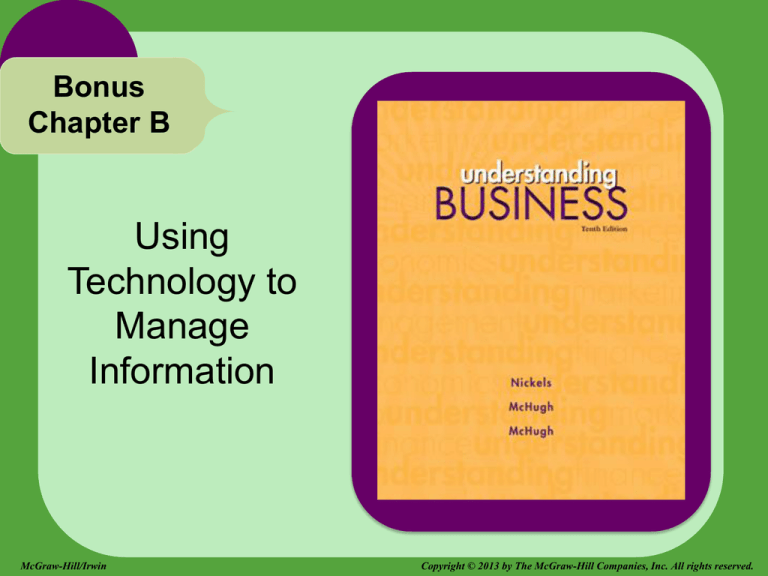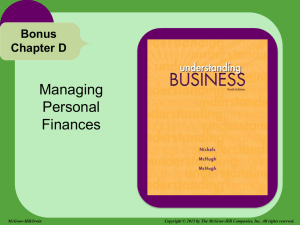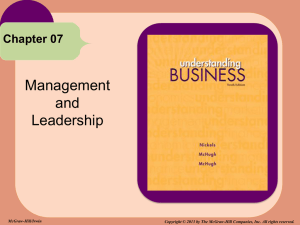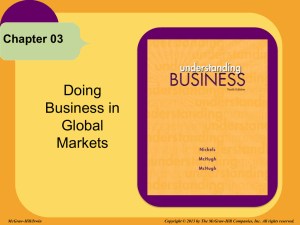
Bonus
Chapter B
Using
Technology to
Manage
Information
McGraw-Hill/Irwin
Copyright © 2013 by The McGraw-Hill Companies, Inc. All rights reserved.
Bonus Chapter
B
LEARNING GOALS
1. Outline the changing role of business
technology.
2. List the types of business information, identify
the characteristics of useful information, and
discuss how data are stored and mined.
3. Compare the scope of the Internet, intranets,
extranets, and virtual private networks and
explain how broadband technology enabled the
evolution to Web 2.0 and 3.0.
B-2
Bonus Chapter
B
LEARNING GOALS
4. Review the computer hardware most frequently
used in business.
5. Classify the types of computer software most
frequently used in business.
6. Evaluate the human resource, security, privacy,
and stability issues affected by information
technology.
B-3
Profile
CHRIS HUGHES
Facebook
• Hughes attached to two of the
biggest recent tech triumphs —
Facebook and the social media
arm of President Barack
Obama’s campaign.
• Had an ability to detect the
features that could develop
Facebook as a brand.
• Launched Jumo to connect nonprofits and charities with
prospective donors.
B-4
Bonus Chapter
B
NAME that COMPANY
This company used social media to build its
business. Its customers design new products,
name them, and enter them in the company’s
database. Customers may even make YouTube
commercials that are featured on the
company’s video wall. If other customers buy
the new product, the creator gets a small store
credit.
Name that company!
B-5
Evolution from
Data Processing
to Business
Intelligence
TECHNOLOGY in the 1970s
LG1
• Data Processing (DP) -- Name for business
technology in the 1970s; primarily used to improve
the flow of financial information.
• Data are the raw, unanalyzed and unorganized
facts and figures.
• Information is processed and organized data that
managers can use for decision-making.
B-6
Evolution from
Data Processing
to Business
Intelligence
TECHNOLOGY in the 1980s
LG1
• Information Systems (IS) -- Technology that helps
a company do business (i.e. ATMs and voicemail).
• In the late 1980s, business technology became
known as information technology.
• Information Technology (IT) -- Technology that
helps change business by allowing companies to use
new methods.
B-7
Evolution from
Data Processing
to Business
Intelligence
LG1
TECHNOLOGY in the
EARLY 2000s
• Business Intelligence (BI) -Any variety of software
applications that analyze an
organization’s raw data and take
useful insights from it.
• BI helps businesspeople focus
on what’s important in the
organization such as deciding
how to react to problems and
opportunities.
B-8
Evolution from
Data Processing
to Business
Intelligence
LG1
FURTHER EVOLUTION
What’s in Store for BI
1. Advanced tools will be
mainstream.
2. Mobile BI will be recharged.
3. Facebook will change how
teams collaborate.
4. Economic recovery causes
BI budget growth.
5. Upgrade fever!
Source: Information Week, January 31, 2011.
B-9
How Information
Technology
Changes
Businesses
LG1
TECHNOLOGY
BRINGS CHANGE
• IT allows a business to serve the customer
whenever and wherever they want.
• As IT broke time
and location
barriers, it created
new organizations
and services that
are independent of
location.
B-10
Evolution from
Data Processing
to Business
Intelligence
LG1
TOP U.S. CITIES by
HIGH-TECH EMPLOYMENT
City
# of People Employed by
High-Tech Firms
New York
310,000
Washington, D.C.
295,000
San Jose/Silicon Valley
225,000
Boston
190,000
Dallas-Fort Worth
175,000
B-11
Progress
Assessment
PROGRESS ASSESSMENT
• How has the role of information technology
changed since the days when it was known as
data processing?
• How has information technology changed the
way we do business?
B-12
Types of
Information
LG2
KEY TYPES of BUSINESS
INFORMATION AVAILABLE
• Business process
information
• Physical-world
observations
• Biological data
• Public data
• Data that indicate personal
preferences or intentions
B-13
Managing
Information
LG2
FOUR CHARACTERISTICS that
MAKE INFORMATION USEFUL
1. Quality
2. Completeness
3. Timeliness
4. Relevance
B-14
Managing
Information
TOP SITES to
KEEP YOU CONNECTED
LG2
• Skype
• Google Docs
• Basecamp
• SurveyMonkey
Source: Entrepreneur, July 2010.
B-15
Organizing
E-Mail and
Electronic Files
LG2
EFFECTIVELY USING YOUR
ELECTRONIC FILES
• Use your e-mail
program’s organizing
tools.
• Use consistent file
names.
• Use online backup
services.
• Use desktop search
software.
B-16
Storing and
Mining Data
LG2
HOW DO YOU
ORGANIZE DATA GLUT?
• A data warehouse stores data on a single
subject for a firm over a specific period.
• Data mining is a technique for looking for hidden
patterns and unknown relationships in the data.
• Tools include Yahoo Pipes that can help
companies mine the web to get correct data.
B-17
Progress
Assessment
PROGRESS ASSESSMENT
• What types of information are available to
businesses today?
• What are the four characteristics of information
that make it useful?
• What is data mining and how do businesses use
it?
B-18
The Road to
Knowledge:
The Internet
BEYOND the INTERNET
LG3
• Intranet -- A companywide network closed to public
access that uses Internet-type technology.
• Extranet -- A semiprivate network that lets more
than one company access the same information or
allows people on different servers to collaborate.
• Virtual Private Network (VPN) -- A private data
network that creates secure connections, or tunnels,
over regular Internet lines.
B-19
Broadband
Technology
INCREASING INTERNET POWER
LG3
• Broadband Technology -- Provides a continuous
connection to the Internet that allows users to send
and receive mammoth video, voice, and data files
faster.
• Internet2 – Private
Internet reserved for
research purposes; runs
more that 22,000 times
faster than today’s public
infrastructure.
B-20
Broadband
Technology
BROADBAND CAPS
LG3
• As people use more bandwidth to stream media,
ISPs have been placing caps on how much a
customer can use.
• Average usage is well below caps.
B-21
Social Media
and Web 2.0
SOCIAL MEDIA
LG3
• Millions have developed online profiles on social
networking sites like Facebook and Twitter.
• Social media is thought to be the future of
successful businesses.
• Manhattan’s 4food relies on social media as
customers create products and use their phones
to save their creations in the restaurant’s
database.
B-22
Social Media
and Web 2.0
WEB 2.0
LG3
• Web 2.0 -- The set of tools
that allow people to build
social and business
connections, share
information and collaborate
on projects online.
• YouTube and Twitter are
among the largest Web
2.0 companies.
B-23
Social Media
and Web 2.0
LG3
AMERICANS and
SOCIAL NETWORKS
Number of Americans with Profiles by Year
Source: Investors Business Daily, June 17, 2011.
B-24
Social Media
and Web 2.0
LG3
AMERICANS and
SOCIAL NETWORKS
Number of Americans with Profiles by Age
Source: Investors Business Daily, June 17, 2011.
B-25
Web 3.0
WEB 3.0
LG3
• Web 3.0 -- A combination of technologies that adds
intelligence and changes how people interact with the
Web and vice versa.
• As you pull data, the system learns about you
and your interests and pushes information you
may like to you.
B-26
Web 3.0
COMPONENTS of WEB 3.0
LG3
1) Semantic Web
2) Mobile Web
3) Immersive Internet
B-27
Progress
Assessment
PROGRESS ASSESSMENT
• How do computer networks change the way
employees gather information?
• What is an enterprise portal?
B-28
Mobile
Devices
LG4
MOVING from a COMPUTERDOMINANT ENVIRONMENT
• We are moving to post-PC applications
designed to connect users to the Internet.
Devices include:
- Smart phones: iPhone
- Notebooks and in-dash
computers in cars
- iPads and other tablets
B-29
Mobile
Devices
LG4
FASTEST-GROWING
CELL PHONE ACTIVITIES
• Using downloaded
applications
• Accessing social
networking sites
• Accessing news
• Listening to music
• Using e-mail
B-30
Mobile
Devices
LG4
The INTELLIGENCE of APPs
What App Developers Don’t Tell You
1. We’re still learning.
2. We track your every move.
3. Some apps can cause
security headaches.
4. You don’t need a lot of
apps.
5. You can’t use many apps
at work!
B-31
Computer
Networks
COMPUTER NETWORKS
LG4
• Network Computing System -- Computer
systems that allow personal computers (clients) to
obtain needed information from databases on a
central computer (server).
• Networks can be expensive.
B-32
Virtualization
and Cloud
Computing
LG4
VIRTUALIZATION and
CLOUD COMPUTING
• Virtualization -- A process that allows networked
computers to run multiple operating systems and
programs through a central computer at the same
time.
• Cloud Computing -- A form of virtualization which
stores a company’s data and applications at off-site
data centers accessed over the Internet.
B-33
Virtualization
and Cloud
Computing
LG4
ADVANTAGES of
CLOUD COMPUTING
1) Reduced software
costs
2) Improved security
3) Capacity
4) Equipment
5) Access
B-34
Virtualization
and Cloud
Computing
LG4
DISADVANTAGES of
CLOUD COMPUTING
1) Security breaches
2) Stability
3) Control of Data
Photo Courtesy of: Peter Baer
B-35
Virtualization
and Cloud
Computing
LG4
CLOUDS in the OFFICE
Companies Using Cloud Computing
Source: Investors Business Daily, June 3, 2011.
B-36
Virtualization
and Cloud
Computing
TOP CLOUD APPLICATIONS
LG4
Source: Investors Business Daily, June 3, 2011.
B-37
Software
LG5
SOFTWARE: TELLING
the COMPUTER WHAT to DO
• Shareware -- Is copyrighted, but is distributed free
of charge with a request that users send a specific
fee to the developer if they decide to use it.
• Public Domain Software (Freeware) -- Software
that is free for the taking.
• SharewareJunkies lists popular programs.
B-38
Progress
Assessment
PROGRESS ASSESSMENT
• How do computer networks change the way
employees gather information?
• What are the major types of computer software
used in business?
B-39
Human
Resource
Issues
LG6
CONTEMPORARY ISSUES in
TECHNOLOGY
• HR managers need to
recruit workers who are
tech savvy and can train
others.
• Technology makes
telecommuting available to
almost all companies.
• Nanobots are mobile
workers who are nearly
autonomous.
B-40
Security
Issues
VIRUSES and PHISHING
LG6
• Virus -- A piece of
programming code inserted into
other programming that usually
lies dormant until triggered;
then causes unexpected,
undesired events.
• Phishing attempts to trick
victims into giving important
information to a bogus
website.
B-41
Security
Issues
LG6
HOW to PROTECT YOURSELF
AGAINST PHISHING
• Don’t respond to emails requesting personal
information.
• Keep your computer updated with anti-virus
software.
• Never provide or verify personal information.
• Never send sensitive personal information over
e-mail.
• Check your monthly statements.
Source: Entrepreneur, May 2010.
B-42
Security
Issues
LAWS and the INTERNET
LG6
• Legal issues surrounding
Internet use:
- Copyright
- Pornography
- Harassment
- Use of Internet for scams
• Cybercrimes cost the U.S
billions each year.
B-43
Security
Issues
CYBERTERRORISM
LG6
• Cyberterrorism is the idea
that terrorist hackers could
shut down:
- Entire communications
- Money supply
- Electricity
- Transportation
B-44
Privacy
Issues
LG6
PRIVACY ISSUES in
TECHNOLOGY
• E-mail can be snooped or information stolen.
• Personal information stored can be stolen.
• Site owners can share your information without
your permission.
• Cookies can track your movement around the
web.
B-45
Progress
Assessment
PROGRESS ASSESSMENT
• How has information technology changed the
way people work?
• What management issues have been affected by
the growth of information technology?
B-46






